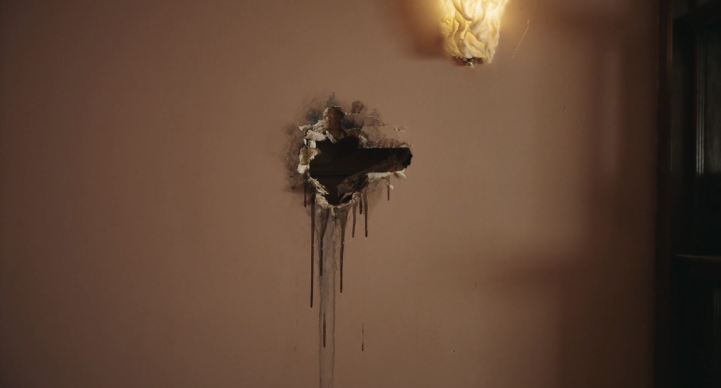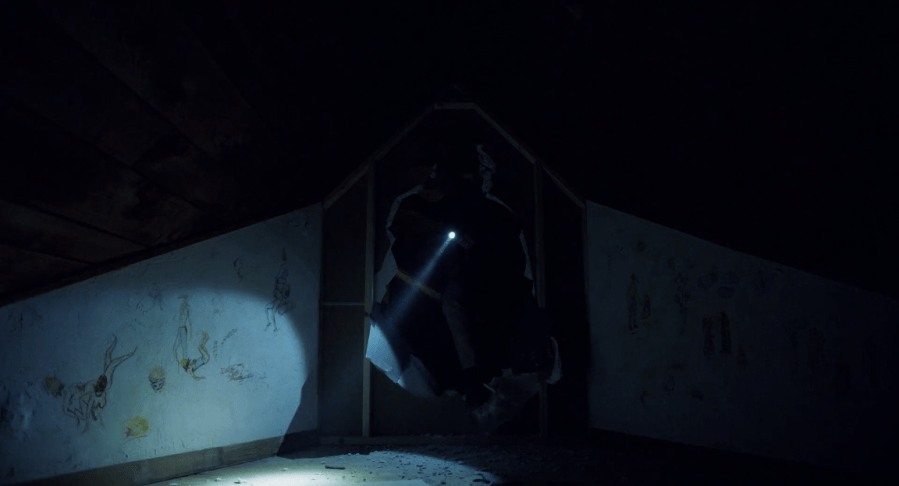Girl on the Third Floor. 2019. Directed & Written by Travis Stevens.
Starring Phil Brooks (a.k.a CM Punk), Trieste Kelly Dunn, Sarah Brooks, Elissa Dowling, Travis Delgado, & Tonya Kay.
Queensbury Pictures
93 minutes
Horror
★★★★
DISCLAIMER: The following essay contains
SIGNIFICANT SPOILERS
 After Travis Stevens produced a slew of films— including a couple of Father Gore’s favourites of the past decade, including A Horrible Way to Die and Starry Eyes, as well as other fun flicks like The Aggression Scale, We Are Still Here, and Buster’s Mal Heart— he finally decided to direct and write his own piece of work. The resulting Girl on the Third Floor is an impressively singular vision in the haunted house sub-genre of horror.
After Travis Stevens produced a slew of films— including a couple of Father Gore’s favourites of the past decade, including A Horrible Way to Die and Starry Eyes, as well as other fun flicks like The Aggression Scale, We Are Still Here, and Buster’s Mal Heart— he finally decided to direct and write his own piece of work. The resulting Girl on the Third Floor is an impressively singular vision in the haunted house sub-genre of horror.
Don Koch (Phil Brooks a.k.a C.M. Punk) is renovating an old property he and his pregnant wife Liz (Trieste Kelly Dunn) bought. He’s doing it on his own, likely because recently he dodged serious charges because he defrauded clients— he was known as “King Don” around town, a captain of industry Wall Street-type. Don has more issues than just being a financial monster. He’s got trouble with temptation. And, in this old, creepy house, he’s tested. He has visions that are erotic and horrific. Soon, the history of the house makes Don’s renovations a hell of a lot harder.
There are numerous ways to tell a haunted house story. Horror has seen so many of them over the years. Stevens reinvigorates the sub-genre by turning the fundamental battle of house v. owner into a deliberate allegory. One way of reading the film is to consider the house itself as woman— specifically, a woman’s body— and Don, as well as his treatment of the house, along with its ghosts, as representative of men in a general sense. Girl on the Third Floor operates in the same sense as a morality tale, where we watch Don grapple with his own treatment of women through his relationship to the house, in all its moaning, marble-dripping, oozy glory.
 Don’s perspective on women comes from the house. View the house as woman in the language of patriarchal property: the house and a woman, in terms of patriarchy, are something for a man to own, sell, design to his liking. Just the basic fact Don thinks someone like him, without any knowledge of how to renovate outside watching YouTube tutorials, can walk into an old house and do everything on his own shows hubris. With all the sexual moaning of the house, and the various near cumshot-like secretions from outlets and faucets, look at Don’s hubris as parallel to the sexual hubris of men who think they know a woman’s body and that they can please her but don’t know the first thing about how a woman’s body actually works.
Don’s perspective on women comes from the house. View the house as woman in the language of patriarchal property: the house and a woman, in terms of patriarchy, are something for a man to own, sell, design to his liking. Just the basic fact Don thinks someone like him, without any knowledge of how to renovate outside watching YouTube tutorials, can walk into an old house and do everything on his own shows hubris. With all the sexual moaning of the house, and the various near cumshot-like secretions from outlets and faucets, look at Don’s hubris as parallel to the sexual hubris of men who think they know a woman’s body and that they can please her but don’t know the first thing about how a woman’s body actually works.
But it’s more than anything simplistically sexual.
The ghostly nature of the oozing and the sounds, as well as the marbles, are signs Don conveniently ignores. He’s actually representative of the stereotypical male, sexually haunted by an inability to understand women. Why else would Liz immediately see the history of the house? She walks right in and experiences it as a brothel 100 years prior. She sees the exploitative things that occurred within the walls, and the nasty things that would go on to create the deformed girl, because she comes to the house from a woman’s perspective. She and the pastor— also a woman— from the Protestant church across the street are eventually the ones who are able to put the house’s spirits to rest. Don, or any man like him, was always doomed. It took women to see into the house’s dark historical web and finally cure the place.
“That house seems to be
bad news for straight men”
 The house’s nasty physical attributes can be seen as symbolic of the female pain that occurred inside. It bleeds and secretes other bodily substances illustrating the thin line between eroticism and violence that existed in that place. In another scene, the scary Nymph pushes through a wall in a terrifyingly vaginal image, showing us what the house’s perversion figuratively birthed in her disfigured, ghostly form.
The house’s nasty physical attributes can be seen as symbolic of the female pain that occurred inside. It bleeds and secretes other bodily substances illustrating the thin line between eroticism and violence that existed in that place. In another scene, the scary Nymph pushes through a wall in a terrifyingly vaginal image, showing us what the house’s perversion figuratively birthed in her disfigured, ghostly form.
Part of the house’s allegorical status is in the idea of the female body as something destroyed by man, whether literally or figuratively. Don putting his hand through the soft spot in the wall— similar to the hole the horrific girl is ‘birthed’ from later— is an act of penetration. He treats the physical structure of the house the way he does Sarah. After he has sex with her, he doesn’t want to know anything about her, he doesn’t want to be around her, similar to the way he doesn’t care about the house’s history, not wanting to know anything about it despite finding things in the walls and so on.
Don wants to tailor the house to his preferences, exactly like the women in his life. He wants to renovate Liz into a perfect mother and wife who doesn’t ask too many questions except how much money he needs. He wants to renovate Sarah into a woman who’ll fuck a married man and keep quiet except whenever he requires sex. His expectations of women are the same as the way men treat women in real life when society forces roles on them, often as caretakers— the way Don sees Liz— or sexual objects— how Don views Sarah— as if there’s nothing in between.
The woman = house imagery used throughout takes on connotations of capitalist ideology. Don’s a white collar criminal who got off light for committing shitty crimes. Fair to say his worldview is stained by capitalism. In an extension of this capitalist view, Don uses women to construct his dream life. He’s using his wife’s money to sustain the renovations and whatever else. He literally uses a dead woman as insulation in the walls after he fucks Sarah and kill hers when he feels his safe little world threatened by infidelity and lies. There ARE supernatural things happening, yes, but Don believes it’s real, so it may as well all be real.
Best exemplifying Don’s bourgeois treatment of women is when he says “I earned that” re: cheating on his wife. He perceives women as something to earn, like capital, or property. Later, his “I can change” moment is a visually literal metaphor, as if saying he’d have to actually shed his skin in order to become a different man.
 The haunted house sub-genre of horror, like zombies and demonic possession, is one that’s all but been worn out. There’s always room for reinvention, though. Girl on the Third Floor helps to turn the idea of a haunted house into something different. There are familiar aspects to Stevens’s film, yet at the core there’s an allegorical meaning, and it isn’t necessarily something we need to dig hard in order to find. Even if Stevens weren’t trying to use the house as a symbolic place, his imagery and story combine into a powerful allegory commenting on ways man’s misogyny is structured, by physically having the house embody the female experience of its effects.
The haunted house sub-genre of horror, like zombies and demonic possession, is one that’s all but been worn out. There’s always room for reinvention, though. Girl on the Third Floor helps to turn the idea of a haunted house into something different. There are familiar aspects to Stevens’s film, yet at the core there’s an allegorical meaning, and it isn’t necessarily something we need to dig hard in order to find. Even if Stevens weren’t trying to use the house as a symbolic place, his imagery and story combine into a powerful allegory commenting on ways man’s misogyny is structured, by physically having the house embody the female experience of its effects.
Phil Brooks is fun in his big role, because he makes you like him. That’s one of the worst parts about many misogynists: they’ll make you like them, even love them, before revealing their true self. Brooks leads us well into that trap with a bit of charm, goof, and plenty of revolted awe. Tonya Kay as the Nymph does fascinating things through body language that makes her character gruesome and hypnotic. The excellent performances are a bonus in a film that deals in heavy themes.
Girl on the Third Floor connects on so many levels. If you choose not to engage with the commentary on misogyny this haunted house romp remains apart from many of the rest due to its near body horror-like treatment of a haunting. You can mark Father Gore down to see anything Stevens directs in the future. He clearly has a unique, horrifying vision and isn’t afraid to stick with it.

